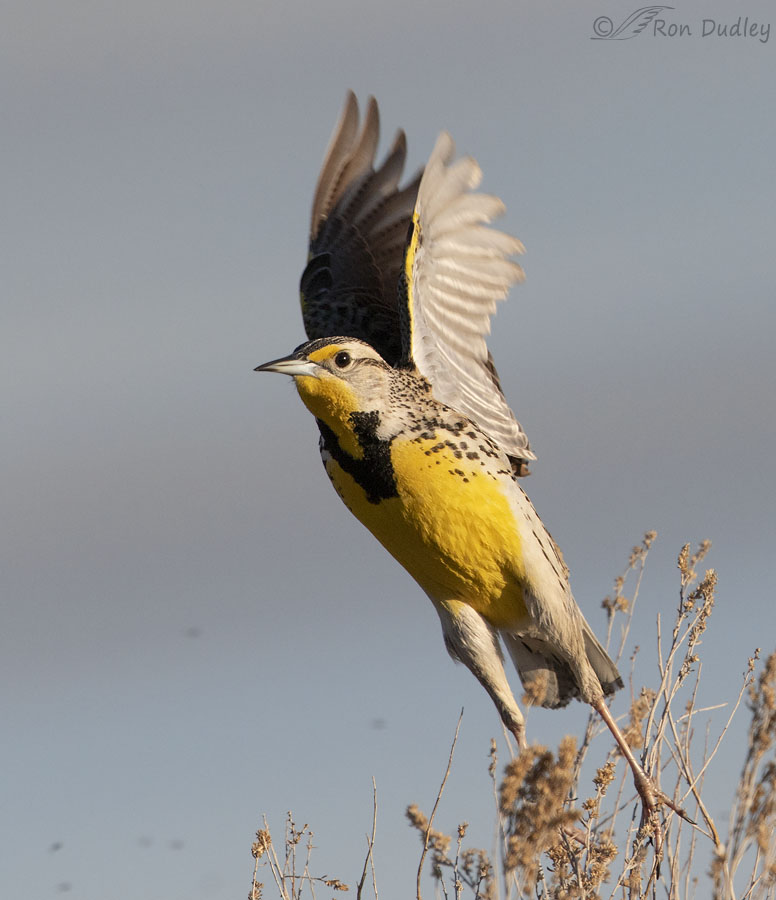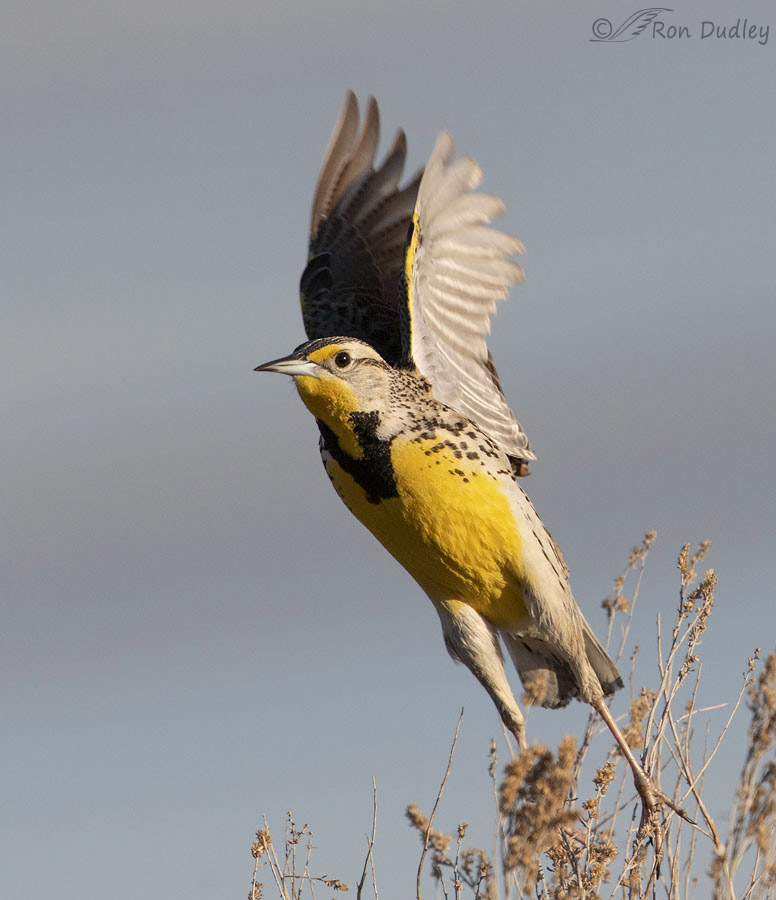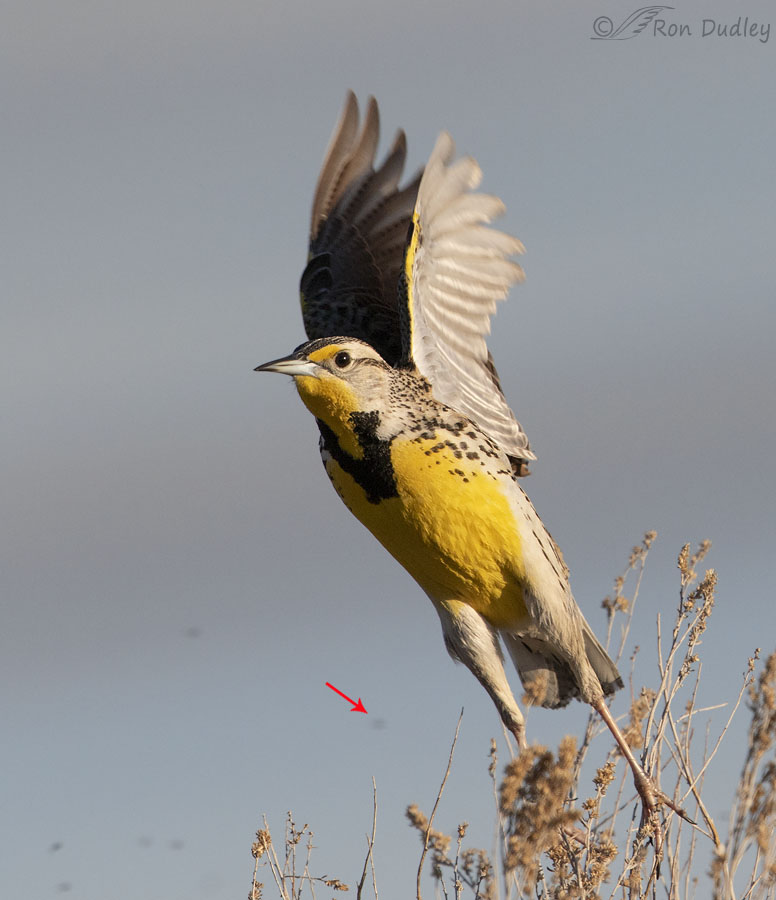What would you do?

1/4000, f/7.1, ISO 800, Canon 7D Mark II, Canon EF 500mm f/4L IS II USM + EF 1.4 III Extender, not baited, set up or called in
I photographed this Western Meadowlark three days ago as it lifted off from rabbitbrush on Antelope Island. I have what I consider to be better takeoff shots of this species but I still think this one has significant merits because all parts of the bird but the wings are sharp, I like the extended takeoff posture, I have eye contact and a catch light, I think both the side light and the composition work well enough and I didn’t clip or cut off any body parts.
I’m less pleased with the wings that are soft due to insufficient depth of field but I don’t think that’s an image-killer.

Here’s another version of the same image. Did you notice the difference between the first version and this one?

Here’s the first version again. There are at least six out of focus dark blobs in the lower left quadrant of the image, I’ve marked one of them with a red arrow. All but one of the others are in the lower left corner of the photo. I cloned the blobs out in version two of the image.
Did you notice the blobs the first time you saw this version? I did and they drive me crazy.
I don’t like them because they look like dust spots on my camera sensor (dust bunnies) and they’re distracting. But in all of my other photos of this bird those blobs don’t exist so I know they really were there (they aren’t dust spots on my sensor.) They’re most likely debris from the rabbitbrush (or less likely tiny insects) disturbed and thrown into the air by the bird’s takeoff.
As a nature photographer I don’t like to use the clone tool to manipulate my photos – nature is nature, both the good and the bad, and “photo art” isn’t my bag. It’s an extremely slippery slope when we start removing or adding elements to our images. However, I have no problem removing sensor dust spots when they occur and in the past I’ve sometimes removed annoying dark spots on otherwise pristine water surfaces so where should the line be drawn? See what I mean about a “slippery slope?”
The way I see it the photographer in a situation like this one has four choices:
- Hitch up your pants and get rid of those damn blobs, big deal.
- Never let the photo see the light of day. The spots ruin the photo – get over it and move on.
- Clone out the blobs but disclose what you’ve done to your viewers and/or consumers.
- Leave the blobs in the photo and just live with them.
With this photo my inclination is #1 – clone the blobs out of the image and there’s no need to disclose what I’ve done. But those blobs are natural so if it’s OK to clone them out why isn’t it OK to clone out an annoying twig in front of the bird’s face or an out of focus bird in the background or any number of other annoying elements that regularly occur in bird photography? Where do nature photographers draw the line? That clone tool can be seductive.
What would you do?
Ron
Note: In bird/nature photography the reputation of the photographer is paramount. Once word gets out that you inappropriately manipulate your photos or bait your subjects or photograph “wildlife” at game farms or cheat at photo contests all is lost, especially if you don’t disclose your methods. That’s why I take things like this so seriously.


Ron, I just thought they were Mia’s no-see-ums and didn’t give them another thought.
Nope, those nasty little devils weren’t out yet, Deena. Won’t be long though.
Those blobs are enough like sensor dust images I wouldn’t feel dishonest cloning them out since I routinely do that with the dust spots on mine. Removing them only helps unclutter an otherwise very simple backdrop. Cloning them out doesn’t do anything that directly or immediately alters the main subject.
Thanks for providing your take on this, Jim.
Little blobs had to go….disclosure or no…a shame to ditch great photos because of some unidentified blobs that are easily removed…
Thanks for your input, Patty.
I saw them right away and prefer the altered image. I did think they were bugs. Apparently you are more honest than I am (I know, hard to believe), but I don’t think such minor fixes need to be reported to the viewer.
“but I don’t think such minor fixes need to be reported to the viewer.”
I can see your point, Ken but where do you (we) draw the line regarding what we report to our viewers and what we don’t?
I am completely with you on the bird ethics – not baited or called in – which affect the birds, but manipulating the images to me is not such a hard line. Now you, being a professional bird photographer who works extraordinarily hard at your craft, and I, who occasionally posts nature photos I took walking the dog on FB are in completely different positions, but I bet you probably freely level and crop your images. Is there really a significant difference between cropping some offending glitch out of the edge of a photo and removing some bugs? As you say in your Note, it is your reputation on the line, so it is not for me to say, but I would not be offended if you cleaned it up and told us or not.
“Is there really a significant difference between cropping some offending glitch out of the edge of a photo and removing some bugs?”
I’d say there is, Ken. In cropping we’re not removing anything that was really there in the part of the image we can see. Not so with cloning.
But I’m not saying my view is for everyone.
Dump the bugs – distracting and do not enhance the gorgeous bird.😎
Poor bugs…
My eye was drawn to the Meadowlark and the spots escaped me.
IF they bother you (and the obviously do) I would tend towards option C, but I can also understand the slipperiness of that slope.
And as a PS perhaps you could decide to ‘only’ clone when the item you are removing is background only and doesn’t ‘touch’ the bird?
It is indeed slippery. Thank you, EC.
A. No big deal.
Disclosing is nice, but not necessary, imo.
Thanks for your perspective, Susan.
Oooh! A multiple-guess quiz! I’d pick C or D.
I didn’t notice any blobs until you pointed them out — I was too mesmerized by the beautiful, bright yellow bird!
Thanks, Marty. Funny how students tend to prefer multiple choice tests over than fill in the blank… 🙂
Another thought just occurred to me. If those spots are indeed insects, it adds another element of “nature” and makes for another area of interest. It changes how you look at the photo. It now tells a story about the surrounding nature as well as just the bird.
Good point, Dan. It seems a little early for insects like that but they could be.
Ron, I’ve been reading your blog long enough to know your feelings on editing images and I respect your thoughts there. I too will alter photos that have dust spots and have been known to remove things that are not natural in pictures (e.g. litter photo bombed a beautiful picture in Lake Louise a few years ago), but that’s where I tend to draw the line. If its natural, I leave it in. I actually thought the blobs in your picture were bugs at first glance, but understand now they are not. As always I enjoy your pictures.
Note: my wife and I just returned from Africa, where I saw more unusual and beautiful birds than I ever imagined existed. Lots of other animals too. Even managed to capture two or three keepers out of the 4000 images I kept. Can’t recommend the trip higher.
David, a good friend, David Sparks, returned not long ago from an extended trip to Tanzania. He’s posting some of those images now and they’re spectacular.
I guess it depends on where you are most comfortable drawing your line. Removing such tiny spots does not bother me as you are doing no alteration to the subject and these are very small.Removing an out of focus tree limb would be more off an issue for me. In either case, disclosure maintains integrity. In the days of black and white nature photography many photographers used manual dodge and burn techniques. This was an accepted practice just as changing the level of exposure of the positive print. Photoshop allows us to go beyond those simple processing techniques, but some manipulation was certainly acceptable and expected. I think disclosure is always best and used in a judicious manner allows for some very pleasing photos that you always present ot us.
I agree, Dan, Disclosure is key.
Last week I participated in a webinar offered by a prestigious nature photography organization. The award-winning photographer taught us some of his methods, including training a fish in his home aquarium to take bait from a leaf hanging over the tank so the photographer could get a shot that looks like he caught the archer fish hitting the insect in an amazing moment of luck and skill. He also taught how he sets up great bokeh backgrounds by photographing 3 different ones, printing and mountain each on a large board, and putting the board on a chair. And he taught the use of a device that can be connected to the camera by a cable and set up in the field so that when a trained eagle regularly and repeatedly from one perch to another, the beam of light is broken and the photographer gets a great shot.
And you’re asking me about dust bunnies?
Relax.
Sorry Martha, but I’ll make my own decisions about when to relax and when not to. For me this is an important issue.
And I’m not asking you about dust bunnies. I explained that that isn’t what they are. If they were dust bunnies I’d have removed them without giving it a second thought. Or mentioning it here.
You are clearly guilty of covering up evidence of UFO’s. And yet by removing these Unidentified Fuzzy Objects your reputation remains intact. The court of slippery slopes finds your arguments persuasive and edifying, and well within the bounds of ethical photography (and that you’ve taken a very nice photo).
I appreciate that, Lyle.
I guess the ‘spots’ are not an issue with me…given that your photos are usually unaltered, seeing them there was natural. I only shoot in jpeg so cropping, maybe brightening a photo is pretty much all I do(don’t know how to use the other things). What bugs me is when I look at an image, am told ‘I don’t photoshop!’ yet you never see skies, grass, etc. that color…you know maybe not ‘photoshop’ but some other post process program was used. If one uses it…admit it…there is more honor in honesty.
You’re absolutely right, Kathy. In my opinion the most common cause of nature photos ruined during processing is oversaturation, to make those colors “pop”.
Many of those photos look more like cartoons than photographs to me. I despise oversaturation in nature photography.
For whatever it’s worth, I’m continually amazed at the nits that drive you bonkers. I’d submit that you might be generally teetering on the edge of bonkers such that a slight breeze can topple you over there 😉 Welcome to my world (for different reasons and different results). While I GET your quest for perfection (if you could see how many times I edit words), in this context I’m good with the life’s-messy concept, too. BUT it doesn’t surprise me at all that you fess up to your perfection addition when necessary. You’re just like that and I like hanging out with ethical folks!
“I’d submit that you might be generally teetering on the edge of bonkers such that a slight breeze can topple you over”
You wouldn’t be the first one to have that opinion, Laura. To quote Popeye “I yam what I yam.”
Clone, I thought you lens was dirty. Disclosure if it makes you more comfortable, it is not like you changed the focal point of your image.
Thanks for your thoughts, Jo.
Humbly, I see the blobs as perhaps larva of abundant insect/aquatic life and the cycles give me hope. But I understand many people would cleanse that out of the final picture, which scrubbed may appear to be just sky and not water. Up to you, master storyteller and life observer. The threads here about what constitutes “processing” reminds me of my brother’s penchant to fix my face devoid of make up to make “it prettier” Drives me nuts. Thanks for an interesting topic during quarantine. Stay healthy.
Thanks for your input, Diane. Just to set the record straight that background is the far away Great Salt Lake.
More coffee, glasses, even with that little red arrow I didn’t notice the blobs! I’m with hitch up your pants..
Just love a picture of any bird taking off
Take Care
Diana, as is obvious from the subject of many of my posts I’m pretty darned fond of takeoff shots too.
In this case I would go for #1. I did not notice them in the first photo because of the Meadowlark’s bold colors and that it was a takeoff. My eyes never got to the blobs. When you asked what was the difference, then when I went back I immediately picked that up. Personally I see no reason to disclose that you removed the blobs. It is not the same as failing to disclose that you removed something solid and significant. When I view your images I am always confident that nothing unethical has been done to enhance their appearance.
“When I view your images I am always confident that nothing unethical has been done to enhance their appearance.”
That means a lot, Everett. And that’s what I mean about “reputation”…
This one seems easy to me. I feel the photographers own their images and have the right to do whatever they wish to them. What is wrong is false-representation of their images. For example: competing an image in a photo contest that clearly states cloning is not allowed; or selling an image knowing the buyer does not want images with cloning, etc. Serious manipulation can yield very-interesting and very-beautiful images. Just not “nature” images.
Richard, In my opinion it goes without saying that every photographer has the “right” to do whatever he/she wants with their own images.
“What is wrong is false-representation of their images”.
It’s also my opinion that significant image manipulation in nature photography without disclosure is “false-representation” by definition. Nature photographers still have the “right” to do it but they should be prepared to say goodbye to their good reputation in many quarters when they do.
First thing I saw was there was no Ron Dudley watermark! Had to go back and look 🙂 I would remove the blobs. I guess one could include the fact that it was post-processed, but that would be true of any RAW image, would it not?
Good eye, Tony! I didn’t notice that missing watermark until right after I published the post. I intend to go back and add my watermark in a few minutes.
Yes, all RAW images have been processed. Processing is generally assumed. But in my view there’s a huge difference between “normal” processing and cloning.
Edit: I’ve now added the missing watermark.
I’m still very new to RAW processing, and relatively new to post-processing. I guess I am not too clear which buttons are normal processing and which exceed the bounds of normalcy. I would have thought removing blemishes, be they in the sky or on the skin of a person was pretty normal – no?
Just wondering.
Tony, in general “normal processing” involves things like converting RAW to jpeg, cropping, sharpening and exposure (brightening, darkening etc.). In nature photography adding or removing elements from our images isn’t considered “normal processing”. After all, it’s “nature” photography and that wouldn’t be natural. Prestigious nature photography contests don’t allow such manipulation for good reason.
Many photographers who consider themselves to be nature photographers do it anyway (without disclosing) but they put their reputation on the line.
Major manipulation in other types of photography is often perfectly acceptable and ethical but it isn’t nature photography.
I like your choice here–show us both versions and explain what you’ve done. I didn’t notice the blobs at all until you pointed them out, and now I can’t help but look at them. For that reason, I prefer the cloned image. I do appreciate your practice of full disclosure.
“now I can’t help but look at them”
Me too, Linda. For me they’re like an eye magnet and they annoy the hell out of me.
I would remove the spots and not give it a second thought.
Thanks for your feedback, David.
I did notice the blobs when looking at the first image and I would clone them out –even if they are “natural” and not dust spots. It could be a slippery slope but I think followers of your blog know that you won’t cross the line (to mix a metaphor).
That’s my inclination too, Justine. But I don’t feel completely comfortable with it. Sometimes there are no perfect solutions.